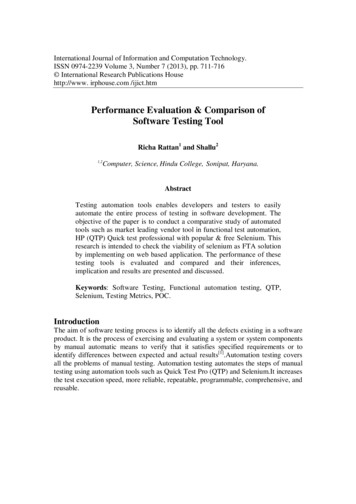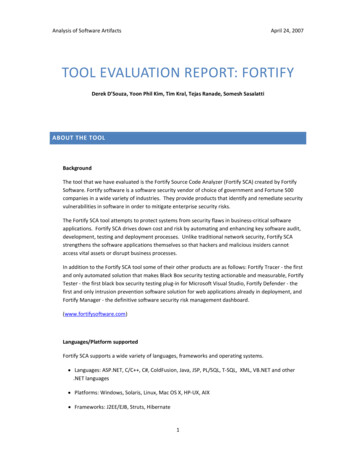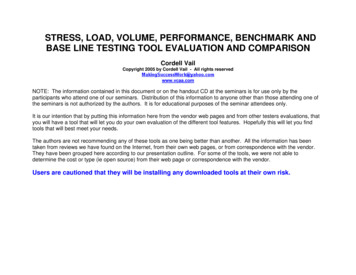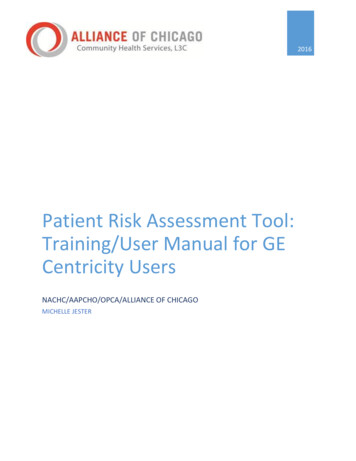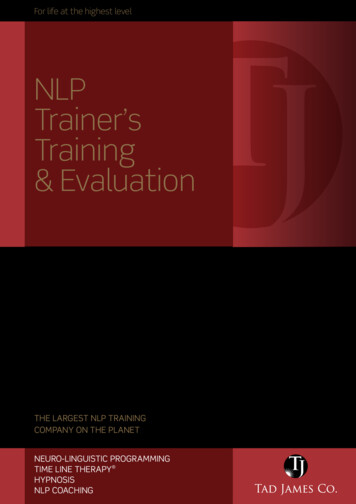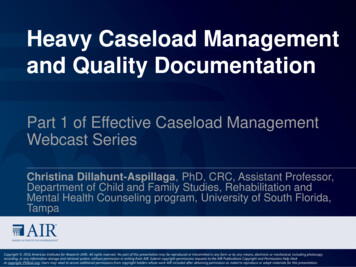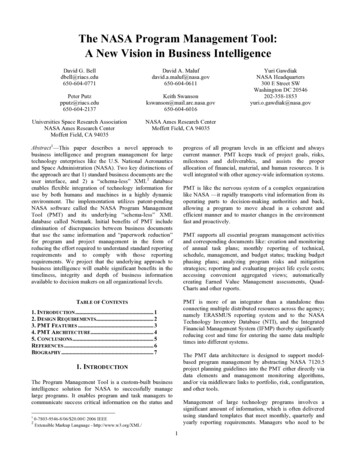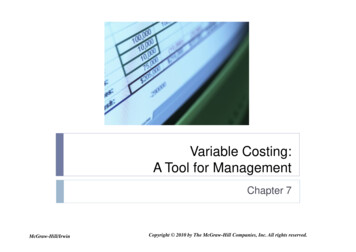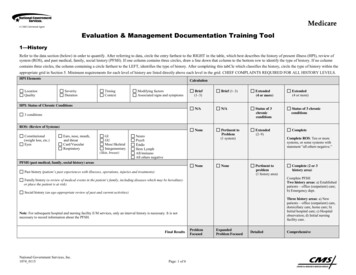
Transcription
Evaluation & Management Documentation Training Tool1—HistoryRefer to the data section (below) in order to quantify. After referring to data, circle the entry farthest to the RIGHT in the table, which best describes the history of present illness (HPI), review ofsystem (ROS), and past medical, family, social history (PFSH). If one column contains three circles, draw a line down that column to the bottom row to identify the type of history. If no columncontains three circles, the column containing a circle farthest to the LEFT, identifies the type of history. After completing this tabCle which classifies the history, circle the type of history within theappropriate grid in Section 5. Minimum requirements for each level of history are listed directly above each level in the grid. CHIEF COMPLAINTS REQUIRED FOR ALL HISTORY LEVELS.HPI TimingContextModifying factorsAssociated signs and symptomsBrief(1–3)Brief (1–3)Extended(4 or more)Extended(4 or more)N/AN/AStatus of 3chronicconditionsStatus of 3 chronicconditionsNonePertinent toProblem(1 system)Extended(2–9)CompleteNonePertinent toproblem(1 history area)HPI: Status of Chronic Conditions3 conditionsROS: (Review of Systems)Constitutional(weight loss, etc.)EyesEars, nose, mouth,and egumentary(Skin, breast)NeuroPsychEndoHem LymphAll/immunoAll others negativeComplete ROS: Ten or moresystems, or some systems withstatement “all others negative.”PFSH (past medical, family, social history) areasNonePast history (patient’s past experiences with illnesses, operations, injuries and treatments)Family history (a review of medical events in the patient’s family, including diseases which may be hereditaryor place the patient is at risk)Social history (an age-appropriate review of past and current activities)National Government Services, Inc.1074 0115Page: 1 of 6Complete PFSHTwo history areas: a) Establishedpatients – office (outpatient) care;b) Emergency dept.Three history areas: a) Newpatients – office (outpatient) care,domiciliary care, home care; b)Initial hospital care; c) Hospitalobservation; d) Initial nursingfacility care.Note: For subsequent hospital and nursing facility E/M services, only an interval history is necessary. It is notnecessary to record information about the PFSH.Final ResultsComplete (2 or 3history area)ProblemFocusedExpandedProblem FocusedDetailedComprehensive
2—ExaminationRefer to data section (table below) in order to quantify. After referring to data, identify the type of examination. Circle the type of examination within the appropriate grid in Section 5.Note: Choose 1995 or 1997 rules, but not both.Calculation – Choose either 1995 or 1997 rules to calculate resultExamination1995Body areas:Head, including faceChest, including breast and axillaeAbdomenNeckBack, including spineGenitalia, groin, buttocksEach extremityOrgan systems:Constitutional (e.g., vitals, gen app)Ears, nose. mouth, SkinNeuroPsychHem/lymph/immEyesFinal ResultsPage 2 of 6One body area orsystem2–7 areas or systems (Minimal detail for areasand/or systems examined; check list typedocumentation without any expansion ofdocumentation of findings)2–7 areas or systems (Expanded documentation ofthe areas and/or systems examined; requires morethan checklists; needs to have normal/abnormalfindings expanded upon)8 or more systems only19971–5 bullets (1 ormore body areas orsystem)Problem Focused6 bullets (1 or more body areas or system)Expanded Problem Focused12 bullets in 2 or more body areas/systems or 2bullets in 6 or more body areas/ systems (excepteye and psych exams, which are 9 bullets)Detailed2 bullets in 9 or morebody areas or systems;or complete singleorgan systemComprehensive
3—Medical Decision MakingNumber of Diagnoses or Treatment OptionsIdentify each problem or treatment option mentioned in the record. Enter the number in each of the categories in Column B in the table below. (There is a maximum number in two categories.)Table 3AA—Problem(s) StatusB—NumberSelf-limited or minor (stable, improved, or worsening)Max 2Est. problem (to examiner); stable, improvedD—Results11Est. problem (to examiner); worseningNew problem (to examiner); no additional workup plannedC—Points2Max 1New problem (to examiner); add workup plannedMultiply the number in columns B—Number and C—Points andput the product in column D—Results. Enter a total for column D,then bring total to line A in the “Final Result for Complexity”table below.34TotalAmount and/or Complexity of Data ReviewedFor each category or reviewed data identified, circle the number in the Points column. Total the points.Table 3BReviewed DataPointsReview and/or order of clinical lab tests1Review and/or order of tests in the radiology section of CPT1Review and/or order of tests in the medicine section of CPT1Discussion of test results with performing physician1Decision to obtain old records and/or obtain history from someone other than patientReview and summarization of old records and/or obtaining history from someone other than patientand/or discussion of case with another health care provider.Independent visualization of image, tracing or specimen itself (not simply review of report)1TotalPage 3 of 622Bring total to line C in final “Result for Complexity” table below.
Risk of Complications and/or Morbidity or MortalityUse the risk table below as a guide to assign risk factors. It is understood that the table below does not contain all specific instances of medical care; the table is intended to be used as a guide.Circle the most appropriate factor(s) in each category. The overall measure of risk is the highest level circled. Enter the level of risk identified in “Final Result for Complexity” table below.Table 3CLevel of RiskPresenting Problem(s) One self-limited or minor problem, e.g., cold insect bite,tinea corporisDiagnostic Procedure(s) Ordered Laboratory tests requiring venipuncture Chest X-rays EKG/ EEG Urinalysis Ultrasound, e.g., echo KOH prepManagement Options Selected Rest Gargles Elastic bandages Superficial dressings Two or more self-limited or minor problems One stable chronic illness, e.g., well controlled hypertensionor noninsulin dependent diabetes, cataract, BPH Acute uncomplicated illness or injury, e.g., cystitis, allergicrhinitis, simple sprain Physiologic tests not under stress, e.g., pulmonary functiontests Noncardiovascular imaging studies with contrast, e.g., bariumenema Superficial needle biopsies Clinical laboratory tests requiring arterial puncture Skin biopsies One or more chronic illness with mild exacerbation,progression, or side effects of treatment Two or more stable chronic illnesses Undiagnosed new problem with uncertain prognosis, e.g.,lump in breast Acute illness with systemic symptoms, e.g., pyelonephritis,pneumonitis, colitis Acute complicated injury, e.g., head injury with brief loss ofconsciousness Physiologic tests under stress, e.g., cardiac stress test, fetalcontraction stress test Diagnostic endoscopies with no identified risk factors Deep needle or incisional biopsy Cardiovascular imaging studies with contrast and no identifiedrisk factors, e.g., arteriogram cardiac catheter Obtain fluid from body cavity, e.g., lumbar puncture,thoracentesis, culdocentesis Minor surgery with identified risk factors Elective major surgery (open, percutaneous or endoscopicwith no identified risk factors) Prescription drug management (continuation & newprescription) Therapeutic nuclear medicine IV fluids with additives Closed treatment of fracture or dislocation withoutmanipulation One or more chronic illnesses with severe exacerbation,progression, or side effects of treatment Acute or chronic illnesses or injuries that may pose a threatto life or bodily function, e.g., multiple trauma, acute MI,pulmonary embolus, severe respiratory distress, progressivesevere rheumatoid arthritis, psychiatric illness with potentialthreat to self or others, peritonitis, acute renal failure An abrupt change in neurologic status, e.g., seizure, TIA,weakness or sensory loss Cardiovascular imaging studies with contrast with identifiedrisk factors Cardiac electrophysiological tests Diagnostic endoscopies with identified risk factors Discography Elective major surgery (open, percutaneous or endoscopicwith identified risk factors) Emergency major surgery (open, percutaneous or endoscopic) Parental controlled substances Drug therapy requiring intensive monitoring for toxicity Decision not to resuscitate or to de-escalate care because ofpoor prognosisMinimalLowModerateHighOver-the-Counter drugsMinor surgery with no identified risk factorsPhysical therapyOccupational therapyIV fluids without additivesFinal Result for ComplexityTable 3DANumber diagnoses or treatment options 1 Minimal2 Limited3 Multiple 4 ExtensiveBAmount and Complexity of Data 1 Minimal2 Limited3 Moderate 4 ExtensiveCHighest RiskMinimalLowStraight ForwardLow ComplexityModerateModerateComplexityHighHigh ComplexityType of decision makingPage 4 of 6Draw a line down any column with 2 or 3 circles to identify thetype of decision making in that column. Otherwise, draw a linedown the column with the second circle from the left. Aftercompleting this table, circle the type of decision making withinthe appropriate grid in Section 5.
4—TimeIf the physician documents total time and indicates that counseling or coordinating care dominates (more than 50%) the encounter, time may determine level of service. Documentation may referto: prognosis, differential diagnosis, risks, benefits of treatment, instructions, compliance, risk reduction and/or discussion with another health care providerQuestionAnswerDoes documentation reveal total time?YesNoDoes documentation describe the content of counseling or coordinating care?YesNoDoes documentation reveal that more than half of the time was counseling or coordinating care?YesNoIf all answers are “yes,” you may select level based on time.5—Level of ServiceOutpatient and Emergency Room (ER)HistoryExaminationComplexity ofmedical decisionAverage time(minutes) (ER hasno average time)LevelNew Office/ER—Requires three components within shaded areaPFEPFDCER: PFER: EPFER: EPFER: DPFEPFDCER: PFER: EPFER: EPFER: DSFSFLMER: SFER: LER: MER: M10 New (99201) 20 New (99202) 30 New (99203) 45 New (99204)CER: CCER: CHER: H60 New (99205)ER (99281)IER (99285)VER (99282)IIER (99283)IIIER (99284)IVEstablished Office—Requires two components within shaded areaPFEPFDMinimal problem that may not requirepresence of physicianCPFEPFDCSFLMH5 VVInpatientHistoryExaminationComplexity of medicaldecisionAverage time (minutes)(Initial observation care hasno average time)LevelPage 5 of 6Initial Hospital/Observation—Requires three components within shaded areaD/CCCD/CCCSF/LMHSubsequent Hospital—Requires two components within shaded areaPF intervalEPF intervalD intervalPFEPFDSF/LMH30 Init hosp (99221)Observation care (99218)50 Init hosp (99222)Observation care (99219)70 Init hosp (99223)Observation care (99220)IIIIII15Subsequent (99231)Observation (99224)I25Subsequent (99232)Observation (99225)II35Subsequent (99233)Observation (99226)III
Nursing Facility CareHistoryExaminationComplexity of medical decisionAverage time (minutes) (Initialobservation care has no average time)LevelInitial Nursing Facility—Requires threecomponents within shaded areasSubsequent Nursing Facility—Requires two components withinshaded areasD/CD/CSF/L25(99304)IPF IEPF intervalEFPL15(99308)IID intervalDM25(99309)IIIC intervalCH35(99310)IVOther Nursing Facility (AnnualAssessment)—Requires threecomponents within shaded areasD intervalCL/M30(99318)Domiciliary, Rest Home (e.g., Boarding Home), or Custodial Care and Home CareNew—Requires 3 components within shaded areaPFEPFDPFEPFDSFLMCCMCCHEstablished—Requires 2 components within the shaded areaPF intervalEPF intervalD intervalPFEPFDSFLMC intervalCM/HLevel20Domiciliary(99324)Home Care(99341)I60Domiciliary(99327)Home Care(99344)IV75Domiciliary(99328)Home Care(99345)V15Domiciliary(99334)Home Care(99347)I60Domiciliary(99337)Home Care(99350)IVPF Problem Focused HistoryExaminationComplexity ofmedical decisionAverage time(minutes)30Domiciliary(99325)Home Care(99342)IIEPF Expanded Problem Focused45Domiciliary(99326)Home Care(99343)III D Detailed C Comprehensive SF Straightforward 25Domiciliary(99335)Home Care(99348)IIL Low M Moderate40Domiciliary(99336)Home Care(99349)IIIH HighMedical necessity of a service is the overarching criterion for payment in addition to the individual requirements of a CPT code. It would not be medically necessary or appropriate to bill ahigher level of evaluation and management service when a lower level of service is warranted. The volume of documentation should not be the primary influence upon which a specific level ofservice is billed. Documentation should support the level of service reported.Resource: Centers for Medicare & Medicaid Services (CMS) Internet-Only Manual (IOM) Publication 100-04, Medicare Claims Processing Manual, Chapter 12, Section 30.6.1References Current Procedural Terminology, American Medical AssociationCMS IOM Publication 100-04, Medicare Claims Processing Manual, Chapter 12, Section 30.6: Evaluation and Management Services Guide: http://www.cms.gov/MLNProducts/downloads/eval mgmt serv guide-ICN006764.pdfPage 6 of 6
Evaluation & Management Documentation Training Tool 1 — History Refer to the data section (below) in order to quantify. After referring to data, circle the entry farthest to the RIGHT in the table, which best describes the history of present illness (HPI), review of system (ROS), and past medical, family, social history (PFSH). If one column .

